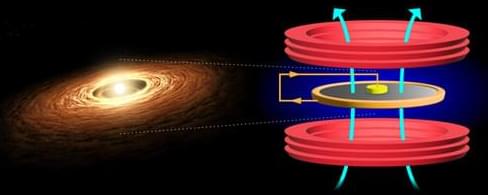Using a magnetically stirred liquid metal, researchers have reproduced a key feature of astrophysical accretion disks: a turbulence-based transfer of angular momentum.
Astrophysical disks are ubiquitous objects in the cosmic landscape: we observe them around matter-gobbling black holes and planet-forming stellar systems. The gas and dust in these disks slowly drift inward and eventually reach the central star or black hole. The energy released in this accretion process makes some of these disks very luminous. However, the physical mechanism responsible for this accretion remains elusive despite 40 years of active research. Now Marlone Vernet from Sorbonne University in France and his colleagues model astrophysical disks with an experimental system based on a rotating disk of liquid metal [1]. The novelty in this experiment is that the disk is set into rotation thanks to electrical currents and magnetic fields in a way that mimics gravity. The experiment provides strong evidence of angular momentum transport, which is thought to be a key feature in astrophysical accretion.
